The Chinese Meteorological Society
Article Information
- LI Xiaofan, LI Tingting, LOU Lingyun. 2014.
- Effects of Doubled Carbon Dioxide on Rainfall Responses to Radiative Processes of Water Clouds
- J. Meteor. Res., 28(6): 1114-1126
- http://dx.doi.org/10.1007/s13351-014-3233-1
Article History
- Received March 21, 2014;
- in final form April 28, 2014
The global temperature increase(Manabe and Wetherald, 1975; Folland et al., 2001; Jones and Moberg, 2003)may correspond to the increase ingreenhouse gas concentration in recent centuries(IPCC, 2001, 2007). The global warming may leadto enhanced precipitation(Fields et al., 1993; Li et al., 2011) and changes in earth systems such as atmospheric circulations(Chen and Held, 2007; Vecchi and Soden, 2007; Wu et al., 2012), hydrological cycle(Manabe and Wetherald, 1975), and ecology(Bazzaz, 1990). Numerical modeling also showedthat the global warming causes the increase in bothregional-scale(Meehl et al., 2005; Tebaldi et al., 2006) and global-scale(Emori and Brown, 2005; Kharin and Zwiers, 2005)precipitation extremes. Recently, Li etal.(2014)conducted cloud-resolving sensitivity experiments to study the effects of doubled CO2on rainfall and found that the enhanced atmospheric warming corresponds to doubled CO2through the reducedinfrared radiative cooling during the summer solstice.The decrease in the mean pre-summer rainfall corresponds to the reduction in the mean infrared radiativecooling. Doubled CO2 enhances the mean tropical atmospheric warming through the accelerated release inthe mean latent heat during the winter solstice. Theincrease in the mean tropical rainfall is related to thestrengthened release of the mean latent heat. In Li etal.(2014), the response of rainfall to radiative processes of clouds is not considered.
Liu et al.(2014)carried out cloud-resolving sensitivity experiments to study the pre-summer torrential rainfall responses to radiative processes of waterclouds in the presence and absence of radiative effectsof ice clouds. In the presence of radiative effects ofice clouds, the exclusion of radiative effects of waterclouds reduces the mean rainfall through the meanhydrometeor change from a loss to a gain due to theweakened melting of graupel and cloud ice caused bythe enhanced local atmospheric cooling. In the absence of radiative effects of ice clouds, the removal ofradiative effects of water clouds enhanced the meanrainfall through the strengthened mean net condensation and increased mean hydrometeor loss. The enhanced mean net condensation and accelerated releaseof the mean latent heat corresponds to the strengthened mean infrared radiative cooling in the lower troposphere. The increased mean hydrometeor loss results from the weakened melting of graupel caused bythe enhanced local atmospheric cooling. In Liu et al.(2014), the effect of CO2 is not considered.
Since the increased CO2 leads to tropospherictemperature increases through radiative processes, theobjective of this study is to study effects of doubledCO2on rainfall responses to radiative processes of water clouds. F ollowing Li et al.(2014), pre-summer and tropical rainfall events were chosen in this study . Theanalysis methodology developed by Liu et al.(2014)isadopted in this study . Different from previous studies(Li et al., 2014; Liu et al., 2014), the present paperinvestigates both the effect of doubled CO2 and theeffect of radiative processes of water and ice clouds ontwo types of rainfalls: the pre-summer rainfall aroundthe summer solstice and the tropical rainfall aroundthe winter solstice. The summer and winter solsticesare selected because these are the time when the solarheating of the earth's atmosphere has the largest difference.
In Section 2, model, and control and sensitivityexperiments are described. The effects of doubled CO2on rainfall responses to radiative processes of waterclouds are analyzed in the presence of radiative effectsof ice clouds in Section 3 and in the absence of radiative effects of ice clouds in Section 4. A summary isgiven in Section 5.2. Model and experiments
Following Li et al.(2014), the pre-summer heavyrainfall event that occurred around the summer solstice and the tropical rainfall event during T ropical Ocean Global Atmosphere-Coupled Ocean Atmosphere Response Experiment(TOGA COARE)thatoccurred around the winter solstice are chosen inthis study . The pre-summer rainfall control experiment(P)is simulated from 0200 Local St and ard Time(LST)3 to 0200 LST 8 June 2008, whereas the tropical rainfall control experiment(C)is simulated from1000 LST 19 to 1000 LST 24 December 1992. Theexperiment P has been validated with rain gauge observ ation(Wang et al., 2010; Shen et al., 2011b) and temperature and specific humidity data from GlobalData Assimilation System(GDAS)developed by theNCEP of the US National Oceanic and AtmosphericAdministration(NOAA). The reanalysis data from theGDAS used in this study may contain large uncertainties(e.g., Brunke et al., 2011; Kumar and Hu, 2012).The precipitation simulations may be sensitive to theuncertainties in initial profiles of temperature, watervapor, and radiation(Li et al., 2006; Li and Shen, 2010; Ran and Li, 2014), depending on temporal and spatial scales of the precipitation event and the largescale forcing. The results from the average over modeldomain and then over a five-day period may not besensitive to the uncertainties of imposed large-scaleforcing from the GDAS because of the same stronglarge-scale forcing used in the experiments. The simulation results from experiment C have been comparedwith the observ ations in terms of rain rate, temperature, specific humidity, and surface solar radiative and latent heat fluxes(Li et al., 1999). The experiment P and associated sensitivity experiments have been usedto study the effects of vertical wind shear and cloudradiative processes(Shen et al., 2011b) and ice( Wang et al., 2010; Shen et al., 2011c) and water(Shen et al., 2011a; Liu et al., 2014)clouds on pre-summer rainfall.The experiment C has been used to study radiative and microphysical effects on improvement of thermodynamic simulations(Li et al., 1999), relation between energy and rainfall(Li et al., 2002a), and dominant microphysical processes(Li et al., 2002b)in tropicalrainfall episodes.
The model used in Li et al.(2014), Liu et al.(2014), and this study is the two-dimensional cloudresolving model(Soong and Ogura, 1980; Soong and Tao, 1980; Tao and Simpson, 1993)that was modi-fied by Sui et al.(1994, 1998) and Li et al.(1999).Detailed descriptions of the model setup and physicspackages can be found in Gao and Li(2008). Themodel contains prognostic equations of perturbationzonal wind and vertical velocity, potential temperature, specific humidity, and five cloud species(cloudwater, raindrops, cloud ice, snow, and graupel). Themodel uses the cloud microphysical parameterizationschemes(Lin et al., 1983; Rutledge and Hobbs, 1983, 1984; Tao et al., 1989; Krueger et al., 1995; also seeTable 1) and the radiation parameterization schemes(Chou et al., 1991, 1998; Chou and Suarez, 1994). Themodel adopts a horizontal resolution of 1.5 km overthe one-dimensional model domain of 768 km, 33 vertical levels, and a time step of 12 s. Due to the smallmodel simulation domain(768 km), large-scale forcingis required to force the model. The model is forced bylarge-scale vertical velocity, zonal wind in experimentsP(see Fig. 1 in Li et al., 2014) and C(see Fig. 2 inLi et al., 2014), and horizontal temperature and water vapor advections(figure omitted). Two more experiments PSR and CORE are conducted. The PSRexperiment is forced by the surface sensible heat and ev aporation fluxes calculated from the GDAS data, whereas the COARE experiment is forced by hourlysea surface temperature(SST)from the Improved Meteorological(IMET)surface mooring buoy(1.75°S, 156°E)(Weller and Anderson, 1996).
 |
| Fig. 1. Vertical profiles of the differences(°C day-1)between(a)PNWR and P(i.e., PNWR-P) and (b)PNWR2 and P2(i.e., PNWR2-P2)for local temperature change(black), condensational heating(red), convergence of vertical heatflux(green), vertical temperature advection(blue), and radiation(orange)averaged for five days over the model domain. |
 |
| Fig. 1. Vertical profiles of the differences(°C day-1)between(a)PNWR and P(i.e., PNWR-P) and (b)PNWR2 and P2(i.e., PNWR2-P2)for local temperature change(black), condensational heating(red), convergence of vertical heatflux(green), vertical temperature advection(blue), and radiation(orange)averaged for five days over the model domain. |
 |
| Fig. 2. Time mean cloud microphysics budgets in(a)P2 and (b)PNWR2. Units for cloud hydrometeors and conversionsare mm and mm h-1, respectively . Cloud microphysical conversion terms and their schemes can be found in Table 1. T0 = 0°C. |
Sensitivity experiments to radiative effects of water clouds for P-type experiments(PNWR, PNIR, PNCR) and for C-type experiments(CNWR, CNIR, CNCR), and sensitivity experiments to doubled carbon dioxide for P(P2; PNWR2, PNIR2, PNCR2) and for C(C2, CNWR2, CNIR2, CNCR2)are conducted. Note that NWR, NIR, and NCR are identical to the control experiment except that no water, ice, and cloud(water and ice)radiation is includedby setting mixing ratios of water, ice, and cloud hydrometeors to zero in the calculations of radiation, respectively . The comparison between NWR and control experiment is analyzed to study radiative effectsof water clouds on rainfall in the presence of radiativeeffects of ice clouds. The comparison between NCR and NIR is analyzed to study radiative effects of water clouds on rainfall in the absence of radiative effectsof ice clouds. The comparison between P2 and P(orC2 and C)is examined to study the effects of doubledcarbon dioxide on rainfall.3. Effects of doubled CO2 on rainfall responsesto radiative processes of water clouds in thepresence of radiative processes of ice clouds
In the presence of radiative effects of ice clouds, exclusion of radiative effects of water clouds reducesthe five-day time and model domain mean pre-summerrain rate during summer solstice(Table 2a), whereasit barely changes the mean tropical rain rate duringwinter solstice(Table 3a)in the current CO2 concentration. When CO2concentration is doubled, the removal of radiative effects of water clouds increases themean pre-summer rain rate(Table 2b)whereas it decreases the mean tropical rain rate(Table 3b). T oexamine the cloud processes that are responsible forsurface rainfall, a cloud budget is calculated and analyzed. The cloud budget is expressed by
where QNC is the net condensation, which representsthe difference between the sum of vapor condensation rate([PCND]), vapor deposition rates for thegrowth of cloud ice([PDEP]), snow([PSDEP]), and graupel([PGDEP]) and the sum of growth of vaporby ev aporation of raindrop([PREVP]), ev aporation ofliquid from graupel surface([PMLTG]), and ev aporation of melting snow([PMLTS]); QCM is hydrometeorchange/convergence; u is zonal wind; total hydrometeor mixing ratio ql is the sum of mixing ratios ofcloud water(qc), raindrops(qr), cloud ice(qi), snow(qs), and graupel is mass integration, and zt and zb are the heights of the top and bottom of the model atmosphere, respectively.
is mass integration, and zt and zb are the heights of the top and bottom of the model atmosphere, respectively. |
 |
In the current CO2concentration, the decrease inthe mean pre-summer rain rate caused by the exclusion of radiative effects of water clouds is associatedwith the mean hydrometeor change from loss in P togain in PNWR(Table 2a), but the mean tropical rainrate is not sensitive to radiative effects of water clouds because the mean net cloud source and hydrometeorchange are not altered in C and CNWR(Table 3a).In the doubled CO2concentration, the increase in themean pre-summer rain rate resulting from the removalof radiative effects of water clouds corresponds to thestrengthened mean hydrometeor loss(Table 2b), butthe reduction in the mean tropical rain rate resulting from the elimination of radiative effects of waterclouds corresponds to the decrease in the mean netcloud source(Table 3b). QCM can be broken down to
whereLiu et al.(2014)analyzed the difference in QCMbetween P and PNWR through the calculations of itscomponents of five cloud species associated with presummer torrential rainfall. While both experimentshave similar QCMR(-0.01 mm h-1), the difference inQCMresults from those in QCMC(0.0 in P versus -0.02mm h-1 in PNWR), QCMI(0.02 mm h-1 in P versus0.0 in PNWR), and QCMG(0.02 mm h-1 in P versus0.0 in PNWR)(see Fig. 3 in Liu et al., 2014). The vapor condensation rate(PCND)is larger in PNWR thanin P forming a source for cloud water in PNWR, whilethe collection rate of cloud water by rain(PRACW) and the accretion rate of cloud water by graupel [PGACW(T < T0)] are larger in P than in PNWR as a resultof the melting of cloud ice to cloud water(PIML T).Compared to those in P, more vapor condensation inPNWR may be related to more water vapor due toless consumption of water vapor as indicated by lessrainfall. Compared to those in PNWR, the melting ofcloud ice to cloud water is the microphysical processthat is responsible for the sink for cloud ice in P . Themelting of graupel to rain(PGMLT)is larger in P than in PNWR, which leads to a sink for graupel in P .
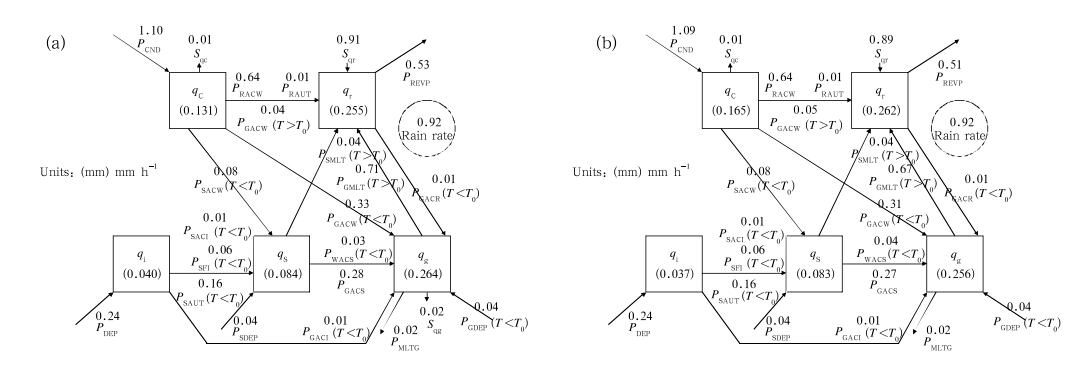 |
| Fig. 3. Time mean cloud microphysics budgets in(a)C and (b)CNWR. Units for cloud hydrometeors and conversionsare mm and mm h-1, respectively . Cloud microphysical conversion terms and their schemes can be found in Table 1. T0 = 0°C. |
To explain the difference in cloud microphysicalprocess, the mean heat budget is analyzed. Following Li et al.(1999), the model domain mean heat budgetcan be expressed by
where w is vertical velocity; θ and qv are air potential temperature and specific humidity;
 , R is the gas constant, cp is the specific heatof dry air at constant pressure p, and p0 = 1000 hPa;p is a mean air density, which is a function of heightonly; Qcn denotes the net latent heat release; QRis the radiative heating rate due to convergence of netflux of solar and infrared radiative fluxes; the variableT denotes model domain mean over the cyclic modeldomain; prime is a perturbation from the horizontalmean; the variable T0 is an imposed observed variable calculated over the observed(non-cyclic)domain, which is the NCEP/GDAS value for pre-summer rainfall case and the observed value from TOGA COAREfor tropical rainfall.
, R is the gas constant, cp is the specific heatof dry air at constant pressure p, and p0 = 1000 hPa;p is a mean air density, which is a function of heightonly; Qcn denotes the net latent heat release; QRis the radiative heating rate due to convergence of netflux of solar and infrared radiative fluxes; the variableT denotes model domain mean over the cyclic modeldomain; prime is a perturbation from the horizontalmean; the variable T0 is an imposed observed variable calculated over the observed(non-cyclic)domain, which is the NCEP/GDAS value for pre-summer rainfall case and the observed value from TOGA COAREfor tropical rainfall.
The decreases in the melting of cloud ice to cloudwater and the melting of graupel to rain from P toPNWR correspond to the enhanced local atmosphericcooling from 2.5 to 4.5 km, which is associated withthe weakened convergence of vertical heat flux from Pto PNWR around 4 km and the strengthened heat divergence and reduced latent heat P to PNWR from 2.5to 4.0 km(Fig. 1a)in response to intensified convergence of vertical heat flux(Fig. 1a), while the decreasein infrared radiative cooling from P to PNWR is small(not shown since radiation is largely determined by infrared radiation hereafter).When CO2concentration is doubled, the difference in QCMresults from the differences in QCMR(0.02 in P2 versus 0.04 mm h-1 in PNWR2) and QCMC(0.0 in P2 versus 0.01 mm h-1 in PNWR2)(Fig. 2).The enhanced mean cloud-water loss results from thedecrease in vapor condensation(PCND) and the increases in accretion of cloud water by snow(PSACW) and collection of cloud water by rain(PRACW) and accretion of cloud water(PGACW)by graupel, whichmay be associated with weakened mean atmosphericcooling from 2 to 3 km(Fig. 1b). The suppressedmean atmospheric cooling corresponds mainly to enhanced release of mean latent heat and reduced meanconvergence of vertical heat flux, which further corresponds to the increases in mean heat divergence and infrared radiative cooling. The increase in mean raindrops loss is related to the reduction in mean rain rate, which is associated with large mass integration mixing ratio of raindrops as a result of the strengthenedmean rain source. The enhanced mean rain sourcecorresponds to the increases in melting of snow torain(PSMLT) and accretion of cloud water by graupel(PGACW) and reduction in accretion of raindropsby graupel(PGACR), which is also associated with reduced mean atmospheric cooling from 2 to 3 km. Notethat doubled CO2 leads to the slowdown in weakenedmean infrared radiative cooling in pre-summer rainfallevent, in particular, in the upper troposphere, whichaccounts for the change from strongly weakened meanatmospheric cooling in PNWR-P to slightly decreasedmean atmospheric cooling in PNWR2-P2.In current CO2concentration, C and CNWR have
similar mean net condensation values because the reduction in the mean condensation caused by the exclusion of radiative effects of water clouds is offset bythe decrease in the mean ev aporation of rain(Fig. 3).The two experiments have similar mean hydrometeorloss due to the fact that the increase in the mean rainhydrometeor loss from C to CNWR is balanced bythe reduction in the mean graupel hydrometeor loss.The enhanced mean rain hydrometeor loss from C to CNWR and the decrease in the mean graupel hydrometeor loss are associated with the weakened Sqr asa result of reduced mean melting of graupel to rain.The reduced mean condensation and weakened melting of graupel to rain may result from the strengthenedmean local atmospheric cooling between 3.0 and 4.5km, which is associated with reduced convergence ofvertical heat flux, weakened release of the mean latentheat(Fig. 4a) and enhanced mean infrared radiativecooling.
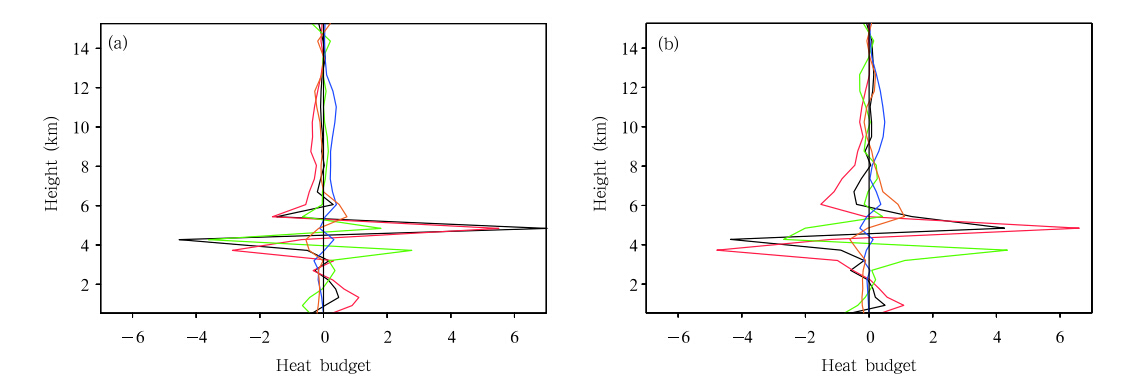 |
| Fig. 4. Vertical profiles of the differences(°C day-1)between(a)CNWR and C(i.e., CNWR-C) and (b)CNWR2 and C2(i.e., CNWR2-C2)for local temperature change(black), condensational heating(red), convergence of verticalheat flux(green), vertical temperature advection(blue), and radiation(orange)averaged for five days over the modeldomain. |
When CO2concentration is doubled, the weakened mean net condensation from C2 to CNWR2 results from the decreases in the mean vapor condensation and deposition to cloud ice(Fig. 5), which isassociated with the suppressed release of the mean latent heat between 2.0 and 4.5 km and above 5.5 km(Fig. 4b). The weakened release of the mean latentheat corresponds to the enhanced mean convergenceof vertical heat flux between 2.0 and 4.5 km and thereduced mean infrared radiative cooling above 5.5 km.The decrease in the mean raindrops hydrometeor lossfrom C2(0.05 mm h-1)to CNWR2(0.03 mm h-1) and the reduction in the mean cloud water gain(-0.01 mm h-1 in C2 vs. 0.0 mm h-1 in CNWR2) and the mean graupel rain(-0.01 mm h-1 in C2 vs. 0.0mm h-1 in CNWR2)lead to the similar mean cloud hydrometeor loss in the two experiments. The weakened mean cloud water gain corresponds to the reduction in the mean vapor condensation from C2 toCNWR2. The weakened mean graupel gain corresponds to the decrease in the mean accretion of cloudwater by graupel from C2 to CNWR2, which is alsoassociated with the decrease in the mean vapor condensation.
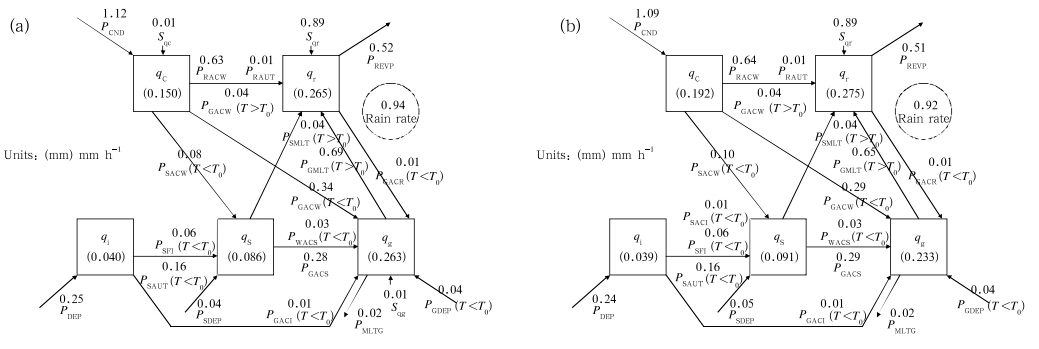 |
| Fig. 5. As in Fig. 3, but for those in(a)C2 and (b)CNWR2. |
In the absence of radiative effects of ice clouds, the exclusion of radiative effects of water clouds increases the mean rainfall through the enhancement inthe mean net condensation and the mean hydrometeorloss in pre-summer rainfall event and the intensification in the mean hydrometeor loss in tropical rainfallevent under the current CO2concentration(Tables 2 and 3). When CO2concentration is doubled, theremoval of radiative effects of water clouds decreasesthe mean pre-summer rainfall through the suppressedmean hydrometeor loss but it enhances the mean tropical rainfall through the strengthened mean hydrometeor loss.
The increase in the mean net condensation fromPNIR to PNCR results from the weakened mean ev aporation of rain(see Fig. 5 in Liu et al., 2014). Thestrengthened mean hydrometeor loss is caused by theenhanced mean rain hydrometeor loss, which is dueto the increase in the mean rainfall. The strengthened mean rainfall is associated with the increase in massintegrated rain hydrometeor mixing ratio from PNIR(0.331 mm)to PNCR(0.336 mm), which correspondsto the increase in Sqr. The increased Sqr is also related to the reduced mean ev aporation of rain. Sincethe ev aporation of rain is determined by the differencebetween specific humidity and saturation specific humidity(Rutledge and Hobbs, 1983), the reduced meanev aporation of rain may be related to the increasedsaturation specific humidity . The increased saturation specific humidity can be demonstrated by thestrengthened mean local atmospheric warming from1.5 to 4.0 km, which is associated with the enhancedrelease of the mean latent heat(Fig. 6a), corresponding to the strengthened mean infrared radiative cooling.
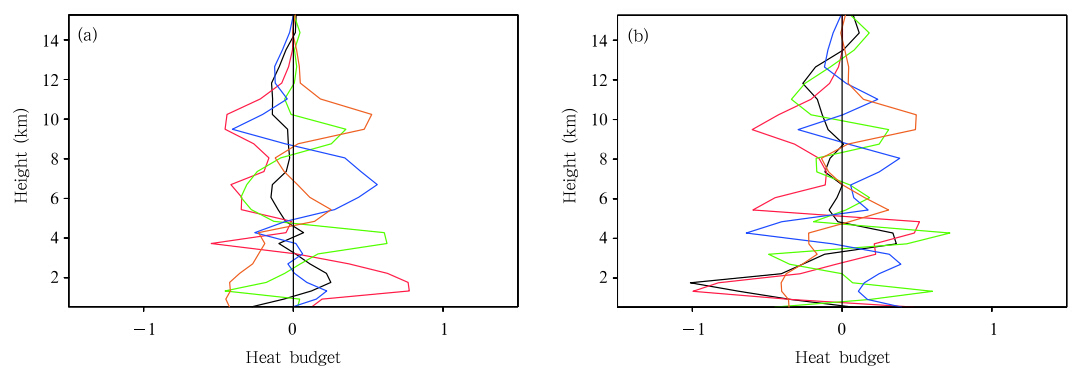 |
| Fig. 6. Vertical profiles of the differences(°C day-1)between(a)PNCR and PNIR(i.e., PNCR-PNIR) and (b)PNCR2 and PNIR2(i.e., PNCR2-PNIR2)for local temperature change(black), condensational heating(red), convergence ofvertical heat flux(green), vertical temperature advection(blue), and radiation(orange)averaged for five days over themodel domain. |
The reduced mean hydrometeor loss from PNIR2to PNCR2 results from the mean cloud water loss inPNIR2 to the mean cloud water gain in PNCR2, whichis associated with the reduction in the mean collectionof cloud water by rain(Fig. 7). The weakened meancollection of cloud water by rain corresponds to thereduced mean vapor condensation and reduced releaseof the mean latent heat below 3 km(Fig. 6b). Thesuppressed release of the mean latent heat and theenhanced mean infrared radiative cooling are partlyoffset by enhanced mean convergence of vertical heatflux and reduced mean heat divergence.
 |
| Fig. 7. As in Fig. 2, but for those in(a)PNIR2 and (b)PNCR2. |
The strengthened mean hydrometeor loss fromCNIR to CNCR is related to the mean rain hydrometeor change from a gain in CNIR to a loss in CNCR, which corresponds to the reduced mean Sqr(Fig. 8). The weakened mean Sqr is mainly associated with thesuppressed mean melting of graupel to rain caused bythe enhanced mean local atmospheric warming around5 km(Fig. 9a). The strengthened mean local atmospheric warming is determined by the increased releaseof the mean latent heat. Note that the enhanced meanlocal atmospheric warming around 5 km is largely off-set by the weakened mean local atmospheric warming around 4 km, the strengthened mean release ofthe mean latent heat around 5 km is largely cancelledby the reduced mean release of the mean latent heataround 4 km, and the suppressed mean convergenceof vertical heat flux around 5 km is largely offset bythe enhanced mean convergence of vertical heat fluxaround 4 km in the vertical mean around 4-5 km whilethe enhanced mean infrared radiative cooling prevails.
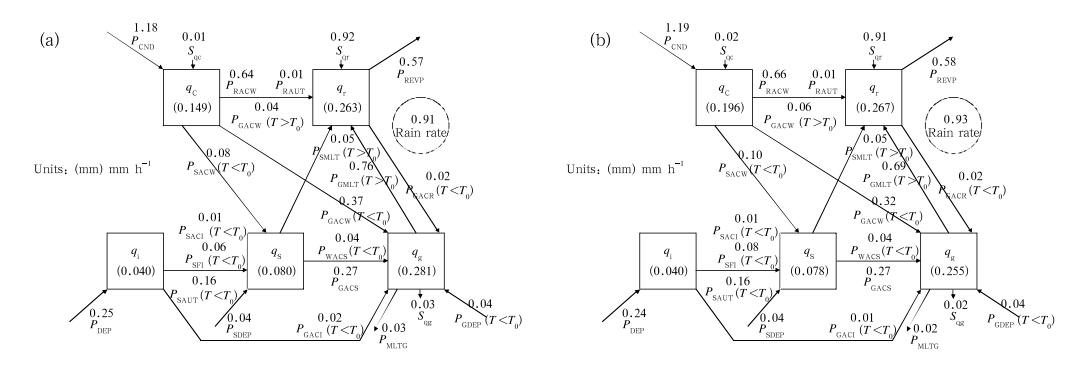 |
| Fig. 8. As in Fig. 2, but for those in(a)CNIR and (b)CNCR. |
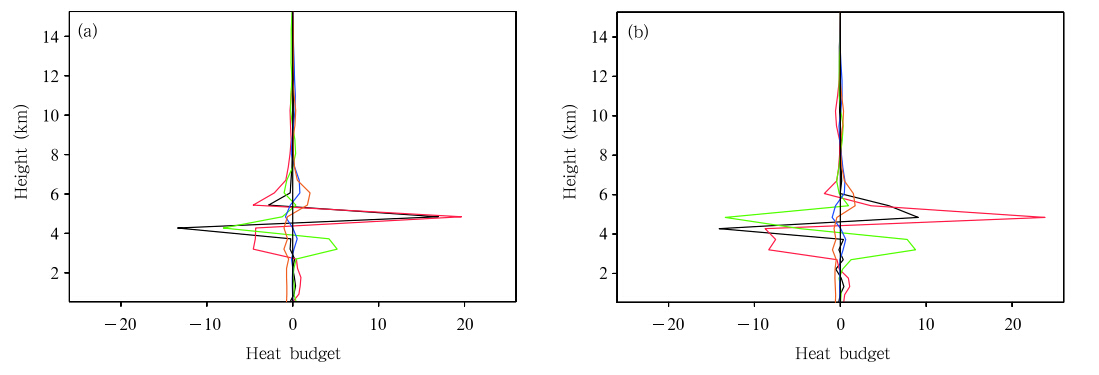 |
| Fig. 9. Vertical profiles of the differences(°C day-1)between(a)CNCR and CNIR(i.e., CNCR-CNIR) and (b)CNCR2 and CNIR2(i.e., CNCR2-CNIR2)for local temperature change(black), condensational heating(red), convergence ofvertical heat flux(green), vertical temperature advection(blue), and radiation(orange)averaged for five days and modeldomain. |
The strengthened mean hydrometeor loss fromCNIR2 to CNCR2 results from the enhanced meanrainfall caused by the increased mass integrated rainmixing ratio, which is associated with the enhancedmean collection of cloud water by rain caused by theenhanced mean vapor condensation(Figs. 10 and 9b).Like CNIR and CNCR, the enhanced mean vapor condensation is caused by the enhanced mean infrared radiative cooling.
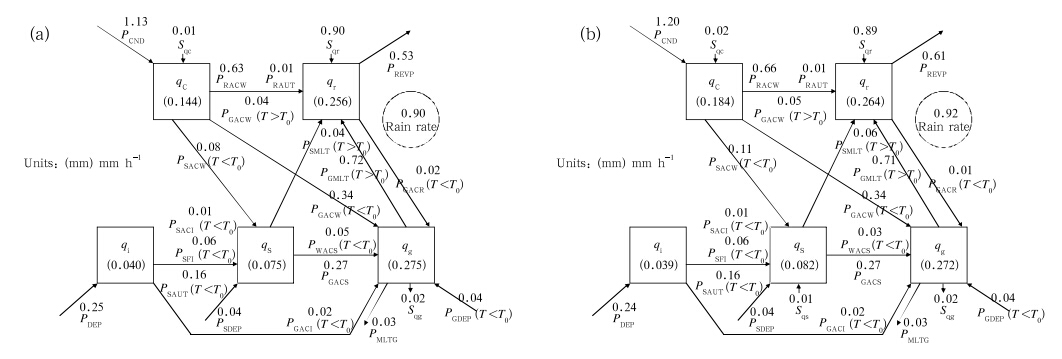 |
| Fig. 10. As in Fig. 2, but for those in(a)CNIR2 and (b)CNCR2. |
The effects of CO2on rainfall responses to radiative processes of water clouds in the presence and absence of radiative processes of ice clouds are respectively examined using a two-dimensional cloud-resolving model in this study . The pre-summer heavy rainfall over southern China around the summer solstice and tropical rainfall during TOGA COARE aroundthe winter solstice are chosen. The relev ant massintegrated cloud microphysical budgets and verticalprofiles heat budgets averaged over five days and model domain are analyzed. The major results areas follows.
(1)In the presence of radiative effects of iceclouds, the removal of radiative effects of water cloudsdecreases the mean pre-summer rainfall through themean hydrometeor change from a loss to a gain causedby the enhanced local atmospheric cooling in current CO2experiment, but it increases the mean presummer rainfall via the enhanced mean hydrometeorloss caused by suppressed mean atmospheric cooling indoubled CO2experiment. The exclusion of radiativeeffects of water clouds barely changes the mean tropical rainfall in current CO2experiment, but it reducesthe mean tropical rainfall through the reduced meannet condensation in response to the suppressed meaninfrared radiative cooling in doubled CO2experiment.
(2)In the absence of radiative effects of ice clouds, the elimination of radiative effects of water clouds enhances the mean pre-summer rainfall through thereduced mean ev aporation of rain associated withthe increased mean local atmospheric warming in thelower troposphere in current CO2experiment, whereasit reduces the mean tropical rainfall via the weakenedmean hydrometeor loss caused by the reduced releaseof the mean latent heat in doubled CO2experiment.
The exclusion of radiative effects of water clouds increases the mean tropical rainfall via the enhancedmean hydrometeor loss caused by the enhanced meaninfrared radiative cooling in the mid troposphere regardless of change in CO2.
Acknowledgment: The authors thank W.-K.Tao at NASA/GSFC for his cloud resolving model.
| [1] | Bazzaz, F. A., 1990: The response of natural ecosystems to the rising global CO2 levels. Annual Review of Ecological and Systematics, 21, 167-196. |
| [2] | Brunke, M. A., Z. Wang, X. Zeng, et al., 2011: An assessment of the uncertainties in ocean surface turbulent fluxes in 11 reanalysis, satellite-derived, and com-bined global datasets. J. Climate, 24, 5469-5493. |
| [3] | Chen, G., and I. M. Held, 2007: Phase speed spectra and the recent poleward shift of Southern Hemisphere surface westerlies. Geophys. Res. Lett., 34, L21805, doi: 10.1029/2007GL031200. |
| [4] | Chou, M.-D., D. P. Kratz, and W. Ridgway, 1991: Infrared radiation parameterization in numerical climate models. J. Climate, 4, 424-437. |
| [5] | —-, and M. J. Suarez, 1994: An efficient thermal infrared radiation parameterization for use in general circu-lation models. NASA Tech. Memo. 104606, Vol. 3, 85 pp. [Available from NASA/Goddard Space Flight Center, Code 913, Greenbelt, MD 20771] |
| [6] | —-, —-, C.-H. Ho, et al., 1998: Parameterizations for cloud overlapping and shortwave single scattering properties for use in general circulation and cloud ensemble models. J. Climate, 11, 201-214. |
| [7] | Emori, S., and S. J. Brown, 2005: Dynamic and thermo-dynamic changes in mean and extreme precipitation under changed climate. Geophys. Res. Lett., 32, doi: 10.1029/2005GL023272. |
| [8] | Fields, P. A., J. B. Graham, R. H. Rosenblatt, et al., 1993: Effects of expected global climate change on marine faunas. Trends in Ecology and Evolution, 8, 361-367. |
| [9] | Folland, C. K., N. A. Rayner, S. J. Brown, et al., 2001: Global temperature change and its uncertainties since 1861. Geophys. Res. Lett., 28, 2621-2624. |
| [10] | Gao, S., and X. Li, 2008: Cloud-Resolving Modeling of Convective Processes. Springer, Dordrecht, 206 pp. IPCC, 2001: Climate Change 2001: The Scientific Basis. Contribution of Working Group I to the Third As-sessment Report of International Panel on Climate Change, Houghton et al., Eds., Cambridge Univer-sity Press, Cambridge and New York, 572 pp. |
| [11] | IPCC, 2001: Climate Change 2001: The Scientific Basis. Contribution of Working Group I to the Third As-sessment Report of International Panel on Climate Change, Houghton et al., Eds., Cambridge Univer-sity Press, Cambridge and New York, 572 pp. |
| [12] | —-, 2007: Climate Change 2007: Mitigation of Climate Change. Contribution of Working Group III to the Fourth Assessment Report of the Intergovernmen-tal Panel on Climate Change, B. Metz et al., Eds., Geneva, Switzerland, 852 pp. |
| [13] | Liu, J., X. Shen, and X. Li, 2014: Radiative effects of water clouds on heat, cloud microphysical and sur-face rainfall budgets associated with pre-summer torrential rainfall. Terr. Atmos. Oceanic Sci., 25, 41-50. |
| [14] | Jones, P. D., and A. Moberg, 2003: Hemispheric and large-scale surface air temperature variations: An extensive revision and an update to 2001. J. Climate, 16, 206-223. |
| [15] | Kharin, V., and F. Zwiers, 2005: Estimating extremes in transient climate change simulations. J. Climate, 18, 1156-1173. |
| [16] | Krueger, S. K., Q. Fu, K. N. Liou, et al., 1995: Improve-ment of an ice-phase microphysics parameterization for use in numerical simulations of tropical convec-tion. J. Appl. Meteor., 34, 281-287. |
| [17] | Kumar, A., and Z.-Z. Hu, 2012: Uncertainty in the ocean-atmosphere feedbacks associated with ENSO in the reanalysis products. Climate Dyn., 39, 575-588. |
| [18] | Li Hongmei, Feng Lei, and Zhou Tianjun, 2011: Multi-model projection of July-August climate extreme changes over China under CO2 doubling. Part I: Precipitation. Adv. Atmos. Sci., 28, 433-447. |
| [19] | Li, X., and X. Shen, 2010: Sensitivity of cloud-resolving precipitation simulations to uncertainty of vertical structures of initial conditions. Quart. J. Roy. Me-teor. Soc., 136, 201-212. |
| [20] | —-, C.-H. Sui, K.-M. Lau, et al., 1999: Large-scale forc-ing and cloud-radiation interaction in the tropical deep convective regime. J. Atmos. Sci., 56, 3028-3042. |
| [21] | —-, —-, and —-, 2002a: Interactions between tropical convection and its embedding environment: An en-ergetics analysis of a 2-D cloud resolving simulation. J. Atmos. Sci., 59, 1712-1722. |
| [22] | —-, —-, and —-, 2002b: Dominant cloud microphysical processes in a tropical oceanic convective system: A 2-D cloud resolving modeling study. Mon. Wea. Rev., 130, 2481-2491. |
| [23] | —-, S. L. Zhang, and D.-L. Zhang, 2006: Thermody-namic, cloud microphysics and rainfall responses to initial moisture perturbations in the tropical deep convective regime. J. Geophys. Res., 111, D14207, doi: 10.1029/2005JD006968. |
| [24] | Li Xiaofan, Shen Xinyong, and Liu Jia, 2014: Effects of doubled carbon dioxide on rainfall responses to the large-scale forcing: A two-dimensional cloud-resolving modeling study. Adv. Atmos. Sci., 31, 525-531, doi: 10.1007/s00376-013-3030-2. |
| [25] | Lin, Y.-L., R. D. Farley, and H. D. Orville, 1983: Bulk parameterization of the snow field in a cloud model. J. Clim. Appl. Meteor., 22, 1065-1092. |
| [26] | Liu, J., X. Y. Shen, and X. F. Li, 2014: Radiative effects of water clouds on heat, cloud microphysical and surface rainfall budgets associated with pre-summer torrential rainfall. Terr. Atmos. Ocean. Sci., 25, 41-50. |
| [27] | Manabe, S., and R. T. Wetherald, 1975: The effects of doubling the CO2 concentration on the climate of a general circulation model. J. Atmos. Sci., 32, 3-15. |
| [28] | Meehl, G. A., J. M. Arblaster, and C. Tebaldi, 2005: Understanding future patterns of increased precipi-tation intensity in climate model simulations. Geo-phys. Res. Lett., 32, doi: 10.1029/2005GL023680. |
| [29] | Ran, L. K., and X. F. Li, 2014: Sensitivity of cloud-resolving precipitation simulations to uncertainty of radiation calculation: Effects of large-scale forcing. Quart. J. Roy. Meteor. Soc., 140, 838-845, doi: 10.1002/qj.2203. |
| [30] | Rutledge, S. A., and P. V. Hobbs, 1983: The mesoscale and microscale structure and organization of clouds and precipitation in midlatitude cyclones. Part VIII: A model for the “seeder-feeder” process in warm-frontal rainbands. J. Atmos. Sci., 40, 1185-1206. |
| [31] | —-, and —-, 1984: The mesoscale and microscale struc-ture and organization of clouds and precipitation in midlatitude cyclones. Part XII: A diagnostic mod-eling study of precipitation development in narrow cold-frontal rainbands. J. Atmos. Sci., 41, 2949-2972. |
| [32] | Shen, X., Y. Wang, and X. Li, 2011a: Radiative effects of water clouds on rainfall responses to the large-scale forcing during pre-summer heavy rainfall over southern China. Atmos. Res., 99, 120-128. |
| [33] | —-, —-, and X. F. Li, 2011b: Effects of vertical wind shear and cloud radiatve processes on responses of rainfall to the large-scale forcing during pre-summer heavy rainfall over southern China. Quart. J. Roy. Meteor. Soc., 137, 236-249. |
| [34] | —-, N. Zhang, and X. Li, 2011c: Effects of large-scale forcing and ice clouds on pre-summer heavy rainfall over southern China in June 2008: A partitioning analysis based on surface rainfall budget. Atmos. Res., 101, 155-163. |
| [35] | Soong, S. T., and Y. Ogura, 1980: Response of trade wind cumuli to large-scale processes. J. Atmos. Sci., 37, 2035-2050. |
| [36] | —-, and W.-K. Tao, 1980: Response of deep tropical cumulus clouds to mesoscale processes. J. Atmos. Sci., 37, 2016-2034. |
| [37] | Sui, C.-H., K.-M. Lau, W.-K. Tao, et al., 1994: The trop-ical water and energy cycles in a cumulus ensemble model. Part I: Equilibrium climate. J. Atmos. Sci., 51, 711-728. |
| [38] | —-, X. Li, and K.-M. Lau, 1998: Radiative-convective processes in simulated diurnal variations of tropical oceanic convection. J. Atmos. Sci., 55, 2345-2359. |
| [39] | Tao, W.-K., and J. Simpson, 1993: The Goddard cu-mulus ensemble model. Part I: Model description. Terr. Atmos. Oceanic Sci., 4, 35-72. |
| [40] | —-, —-, and M. McCumber, 1989: An ice-water satura-tion adjustment. Mon. Wea. Rev., 117, 231-235. |
| [41] | Tebaldi, C., K. Hayhoe, J. Arblaster, et al., 2006: Going to the extremes: An intercomparison of model-simulated historical and future changes in extreme events. Climatic Change, 79, 185-211. |
| [42] | Vecchi, G. A., and B. J. Soden, 2007: Global warming and the weakening of the tropical circulation. J. Climate, 20, 4316-4340. |
| [43] | Wang, Y., X. Shen, and X. Li, 2010: Microphysical and radiative effects of ice clouds on responses of rainfall to the large-scale forcing during pre-summer heavy rainfall over southern China. Atmos. Res., 97, 35-46. |
| [44] | Weller, R. A., and S. P. Anderson, 1996: Surface mete-orology and air-sea fluxes in the western equatorial Pacific warm pool during TOGA COARE. J. Climate, 9, 1959-1990. |
| [45] | Wu, Y. T., R. Seager, M. F. Ting, et al., 2012: At-mospheric circulation response to an instantaneous doubling of carbon dioxide. Part I: Model experi-ment and transient thermal response in the tropo-sphere. J. Climate, 25, 2862-2879. |
 2014, Vol. 28
2014, Vol. 28







